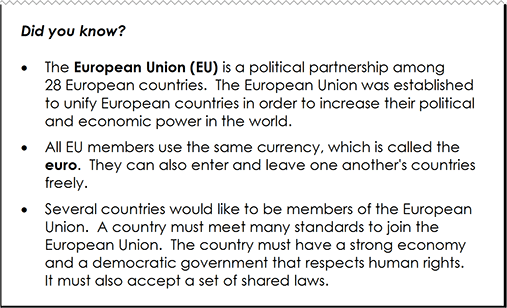Test Information Guide
Field 54: English as a Second Language
Sample Open-Response Item
The following materials contain:
- Sample test directions for the open-response item
- A sample open-response item
- An example of a strong response to the open-response item
- The scoring rubric
Sample Test Directions for Open-Response Items
This section of the test consists of two open-response item assignments. You will be asked to prepare a written response of approximately 150–300 words for each assignment. You should use your time to plan, write, review, and edit your response for each assignment. You must write responses to both of the assignments.
For each assignment, read the topic and directions carefully before you begin to work. Think about how you will organize your response.
As a whole, your response to each assignment must demonstrate an understanding of the knowledge of the field. In your response to each assignment, you are expected to demonstrate the depth of your understanding of the subject area by applying your knowledge rather than by merely reciting factual information.
Your response to each assignment will be evaluated based on the following criteria.
- PURPOSE: the extent to which the response achieves the purpose of the assignment
- SUBJECT KNOWLEDGE: appropriateness and accuracy in the application of subject knowledge
- SUPPORT: quality and relevance of supporting evidence
- RATIONALE: soundness of argument and degree of understanding of the subject area
The open-response item assignments are intended to assess subject knowledge. Your responses must be communicated clearly enough to permit valid judgment of the evaluation criteria by scorers. Your responses should be written for an audience of educators in this field. The final version of each response should conform to the conventions of edited American English. Your responses should be your original work, written in your own words, and not copied or paraphrased from some other work.
Be sure to write about the assigned topics. You may not use any reference materials during the test. Remember to review your work and make any changes you think will improve your responses.
Sample Open-Response Item
Objective 0010
Prepare an organized, developed analysis related to one or more of the following: foundations of second-language instruction; second-language and content learning.
Use the information below to complete the exercise that follows.
A middle school ESL teacher uses a variety of strategies for monitoring English language learners' academic language proficiency and literacy development. In one informal assessment, the teacher has sixth-grade English language learners silently read a short passage from a sixth-grade social studies textbook and then complete a brief written task related to the text. Shown below is an excerpt from the passage.
Did you know? Bullet: The European Union open parenthesis capital E capital U close parenthesis is a political partnership among twenty eight European countries. The European Union was established to unify European countries in order to increase their political and economic power in the word. Bullet: All capital E capital U members use the same currency, which is called the euro. They can also enter and leave one another's countries freely. Bullet: Several countries would like to be members of the European Union. A country must meet many standards to join the European Union. The country must have a strong economy and a democratic government that respects human rights. It must also accept a set of shared laws.
The teacher asks students to describe the main ideas of this passage in their own words. Shown below is one student's written response. This student is an expanding-level English language learner.
Note that spelling errors occur in the first sentence. The European Union is a force to powerfel in the world. All the countries in the world want to join the capital E capital U so that country can increase their political and economic power. And they can use the euro. And they can enter and leave another's countries freely. However not all countries are possible to exist in the capital E capital U because they don't have a economy strong and a democratic. Or they don’t respect human rights. Or they don't have a set of shared laws.
Using your knowledge of second-language and content learning, write a response in which you:
- identify and describe one area of strength in the student's academic language proficiency and literacy development in English (e.g., reading comprehension, application of reading comprehension skills and strategies, knowledge of general academic and content-specific vocabulary, application of writing conventions, knowledge of Standard English);
- identify and describe one area for improvement in the student's academic language proficiency and literacy development in English (e.g., reading comprehension, application of reading comprehension skills and strategies, knowledge of general academic and content-specific vocabulary, application of writing conventions, knowledge of Standard English); and
- identify and describe one instructional strategy you would use to address the area for improvement you have identified.
Be sure to cite specific evidence from the information provided to support your response.
Sample Strong Response to the Open-Response Item
The sample response below reflects a strong knowledge and understanding of the subject matter.
The student's summary shows strength in general academic vocabulary, or "Tier 2" words. The student shows s/he comprehends these words from the passage by using them in the summary in original ways. The passage states that the EU was created so that European countries could increase their collective power. The student shows understanding of the words "increase" and "power" by writing that the reason countries want to join the EU is to increase their own power. S/he also logically concludes that the EU is a "powerful" force in the world. The student produces his/her own general academic vocabulary words such as "force," "possible," and "exist." General academic vocabulary is used throughout all types of academic texts, so this student can use it across content areas.
An area for improvement would be writing conventions. The student can produce complex sentences with subordinating conjunctions, but when it comes to adding details, s/he often resorts to tacking on short sentences beginning with conjunctions, e.g., "And they can use the euro. And they can enter ... freely." The student should learn how to incorporate a series of independent clauses with the same subject into a single sentence to avoid repetition and consolidate ideas within written sentences.
An effective instructional strategy would be a shared writing lesson that challenges students to describe a geography-related picture by using a single descriptive sentence. Students would brainstorm three or four descriptors of the picture, to be written in short sentences on the board. The teacher would then demonstrate how to combine those sentences into a single longer sentence, perhaps including instruction on conjunctions and punctuation. Next, the students would work in pairs using new pictures and a graphic organizer to guide them through three steps: (1) writing ideas, (2) writing short sentences, and (3) combining the short sentences into one. The pairs would work together to ultimately develop a single sentence for publishing on the bulletin board. This lesson will give the student writing about the EU a strategy for crafting smooth, effective sentences in the content areas, so instead of tacking on short descriptions, s/he could write, "[Countries] ... can increase their political and economic power, use the euro, and enter ... freely."
Scoring Rubric
Performance Characteristics
The following characteristics guide the scoring of responses to the open-response item(s).
| Purpose | The extent to which the response achieves the purpose of the assignment. |
|---|---|
| Subject Matter Knowledge | Accuracy and appropriateness in the application of subject matter knowledge. |
| Support | Quality and relevance of supporting details. |
| Rationale | Soundness of argument and degree of understanding of the subject matter. |
Scoring Scale
The scoring scale below, which is related to the performance characteristics for the tests, is used by scorers in assigning scores to responses to the open-response item(s).
| Score Point | Score Point Description |
|---|---|
| 4 |
The "4" response reflects a thorough knowledge and understanding of the subject matter.
|
| 3 | The "3" response reflects an adequate knowledge and understanding of the subject matter.
|
| 2 | The "2" response reflects a limited knowledge and understanding of the subject matter.
|
| 1 | The "1" response reflects a weak knowledge and understanding of the subject matter.
|
| U | The response is unrelated to the assigned topic, illegible, primarily in a language other than English, not of sufficient length to score, or merely a repetition of the assignment. |
| B | There is no response to the assignment. |


